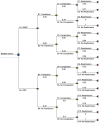Cost-utility analysis of robotic-assisted radical cystectomy for bladder cancer compared to open radical cystectomy in the United Kingdom
- PMID: 36174057
- PMCID: PMC9522012
- DOI: 10.1371/journal.pone.0270368
Cost-utility analysis of robotic-assisted radical cystectomy for bladder cancer compared to open radical cystectomy in the United Kingdom
Abstract
Background: Bladder cancer is the tenth most common cancer in the United Kingdom. Currently, open radical cystectomy (ORC) is the gold standard. Due to the risk of complications and a 2.3-8% mortality rate1, there is growing interest in the use of robot-assisted radical cystectomy (RARC). The aim of this study is to perform a cost-utility analysis, comparing RARC to ORC for bladder cancer patients from the perspective of the National Health Service England.
Methods: A three-stage decision tree: surgery, post-surgery transfusions and complications, in a 90-day time horizon, was produced to simulate possible pathways of patients. The incremental cost-effectiveness ratio (ICER) was calculated based on data derived from current literature. Multiple univariate sensitivity analysis was carried out to evaluate influences of varying costs of RARC and ORC on the ICER.
Results: The ICER for RARC compared to ORC resulted in £25,536/QALY. At the lower threshold of £20,000/QALY, RARC resulted in a negative NMB (£-4,843.32) and at the upper threshold of £30,000/QALY, a positive NMB (£624.61) compared to ORC. Threshold analysis showed that the intervention costs of £13,497 and £14,403 are met at the lower and upper threshold respectively. The univariate sensitivity analysis showed that the intervention costs of RARC or ORC, and the probabilities of complications, had the greatest impact on the ICER.
Conclusion: As the resultant ICER did not fall below the £20,000/QALY threshold, our study did not provide a definitive recommendation for RARC for bladder cancer. Negative values for the NMB at the lower threshold indicated the intervention was not feasible from a cost perspective. At the upper threshold of £30,000/QALY, this situation was reversed. The intervention became cost-effective. Therefore, further research is needed to justify the intervention.
Conflict of interest statement
The authors have declared that no competing interests exist.
Figures






References
-
- Bladder cancer incidence statistics [Internet] Cancer Research UK. 2015 [cited 2021 Apr 4]. Available from: https://www.cancerresearchuk.org/health-professional/cancer-statistics/s....
-
- Lotan Y, Choueiri TK. Clinical presentation, diagnosis, and staging of bladder cancer [Internet]. 2020 [cited 2021 Mar 23]. Available from: https://www-uptodate-com.iclibezp1.cc.ic.ac.uk/contents/clinical-present....
-
- Types—Bladder cancer—Cancer Research UK [Internet]. [cited 2021 Apr 10]. Available from: https://www.cancerresearchuk.org/about-cancer/bladder-cancer/types-stage....
-
- Recommendations—Bladder cancer: diagnosis and management—Guidance—NICE [Internet]. NICE; [cited 2021 Apr 10]. Available from: https://www.nice.org.uk/guidance/ng2/chapter/1-Recommendations#treating-....
-
- Stenzl A, Sherif H, Kuczyk M. Radical cystectomy with orthotopic neobladder for invasive bladder cancer: a critical analysis of long term oncological, functional and quality of life results. Int Braz J Urol Off J Braz Soc Urol. 2010. Oct;36(5):537–47. doi: 10.1590/S1677-55382010000500003 - DOI - PubMed
MeSH terms
LinkOut - more resources
Full Text Sources
Medical
Research Materials
Miscellaneous

